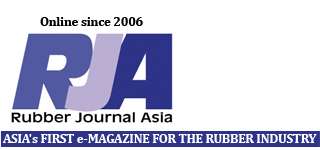 WITH the current demand to incorporate “green” technologies in lifestyles and a need to protect the planet’s resources, many companies are under pressure to introduce more eco-friendly technologies.
WITH the current demand to incorporate “green” technologies in lifestyles and a need to protect the planet’s resources, many companies are under pressure to introduce more eco-friendly technologies.
German speciality chemicals firm Lanxess is taking this cue with its product line up for the tyre market, especially since tyres contribute to 24% of a vehicle’s carbon dioxide emissions and up to 30% fuel consumption. The firm says its neodymium polybutadiene (Nd-PBR) rubber is a key enabler of greener tyres and it is building a facility for this in Singapore, its fifth global site.
PRA caught up with Joachim Grubb, Head of the Performance Butadiene Rubbers Business Unit to find out more about the Nd-PBR project and how it is able to achieve greener tyres.
PRA : Please explain briefly Lanxess’s Nd-PBR plant project in Singapore and why Lanxess has selected Singapore as the location?
Joachim Grubb : With an investment of EUR200 million, the Nd-PBR plant in Singapore will be the second largest investment project in our company’s history (the first being the EUR400 million butyl rubber plant also on Jurong Island in Singapore). It will be the largest facility of its kind with a capacity of 140,000 tonnes/year. We decided to locate the Nd-PBR plant on Jurong Island to enjoy the synergies of the butyl rubber plant, which will start up in the first quarter of 2013. We are making progress on the project and engineering work on the Nd-PBR plant is well advanced. We recently signed contracts with key suppliers like Petrochemical Corporation of Singapore (PCS) to supply butadiene and TP Utilities to provide steam services. The groundbreaking is targeted for September this year and plant start-up is expected in 2015. We selected Singapore to take advantage of the country’s highly skilled workforce, easy accessibility to raw material supply and its right environment for innovation and technology. It is also an ideal location because of the large sea port that allows easy access to our Asian customers.
PRA : What market share does Lanxess have in the Nd-PBR sector?
Joachim Grubb :We are the leading manufacturer by volume. The current production of Nd-PBR in Asia Pacific is small and we will change this scenario with our new project. We also produce Nd-PBR at our other sites in Brazil and the US, where capacity expansions are being undertaking with debottlenecking. With the Singapore facility, we will have a total output of 940,000 tonnes globally. We will lead not only in size but product properties, too.
PRA : What factors are driving the growth of Nd-PBR globally?
Joachim Grubb : The demand for high-performance rubbers like Nd-PBR is being driven by the megatrend mobility, especially in the emerging markets in Asia, as the middle classes there become more affluent.In addition, demand is accelerated by tyre labelling being introduced around the world. In Japan, this has been implemented since 2010 while discussions are underway in China and the US and South Korea will introduce the labelling at the end of 2012 as will the European Union. Tyres will be graded from A to G according to their fuel efficiency, wet grip and rolling noise. These labels will give consumers the ability to identify the safest, quietest and most fuel efficient tyres Green tyres may cost more than standard tyres, but they reduce fuel consumption by up to 7%. Consumers will therefore benefit in the long run.
PRA : How different is the chemical structure of the Nd-PBR produced by Lanxess, compared to competitors?
Joachim Grubb : Lanxess’s Nd-PBR has the lowest glass transition temperature among all the polybutadienes, especially those made of cobalt and nickel. It also has a unique macrostructure in terms of molecular weight distribution, allowing for a perfect combination of polymer chains. This gives it a higher rebound factor for lower rolling resistance in tyres. The Nd-PBR’s low polydispersity, high linearity and lowest number of free polymer chain ends relative to Mooney are a tool to widening the area of the “Magic Triangle” in tyres: for grip, durability and rolling resistance reduction. But we are always looking to improving the properties and are doing by adjusting the catalyst system. We are using a Zieglar Natta catalyst that will allow us to modify the polymer to get better properties.
PRA : What are the benefits of the use of Nd-PBR in tyres and does it mean that it will overtake the use of natural rubber?
Joachim Grubb : Our Nd-PBR is used in the treads and sidewalls of tyres and we supply to almost 80% of tyre makers. It makes the tyre highly resistant to abrasion and plays a significant role in making tyres more durable and safer. It also lasts long due to lower heat build-up tendency. In addition, Nd-PBR increases recycle times of tyre retreading. At the moment, about 40% of a high performance tyre consists of different synthetic rubbers and natural rubber is still used for truck and car tyres but we expect the overall distribution to change. However, NR will still play a big part in the market.
PRA : What is the future outlook of the Nd-PBR market and Lanxess’s role in this?
Joachim Grubb : We expect the positive economic trend to continue in the following years, especially in the tyre and automotive industries. We are in growth mode and will be rolling out our planned investments in the coming months in order to capitalise on the mega-trends – especially mobility – in China, India and Brazil. In the next few years, we will be focusing on more product innovations that enable customers to meet the challenges of growing mobility worldwide. We also plan on expanding production capacities as well as enhancing customer support by acquiring state-of-the-art services and solutions that add value to the business. (PRA)
